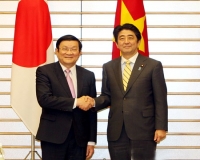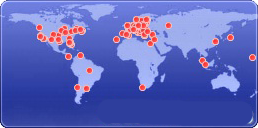Elevating Vietnam - Japan extensive strategic partnership

Nhan Dan journalist Pham Dao recaps President Truong Tan Sang’s recent visit to Japan.
The special aircraft carrying President Truong Tan Sang and his delegation took off from Kansai International Airport in Osaka on March 19, concluding the State-level visit to Japan.
The special aircraft carrying President Truong Tan Sang and his delegation took off from Kansai International Airport in Osaka on March 19, concluding the State-level visit to Japan.
During their four-day stay in Japan, President Sang and the high-ranking delegation accompanying him had a busy diplomatic schedule filled with important meetings with the Japanese leaders including talks with Prime Minister Shinzo Abe, meetings with the Emperor Akihito, the Royal family, Government, political party leaders, major enterprises and corporations, organisations and individuals who, over the past 40 years, made great contributions to fostering the co-operative relations between the two countries.
PM Abe affirmed that President Sang’s visit to Japan was an event of great political significance, further cementing the Japan - Vietnam bilateral ties and lifting them to new heights.
In the second day of the visit, Emperor Akihito presided over a welcome ceremony for the Vietnam President. Every year, the Emperor hosts only two welcome ceremonies for foreign Heads of State and meets them only once for each visit. President Truong Tan Sang and the Vietnamese delegation received a special and warm reception from the Royal family. The Emperor and all of the Royal members hosted a welcome ceremony and a banquet as well as bid farewell to their guests when the Vietnamese delegation left Tokyo for Osaka.
Along the road from New Otani Hotel to the Imperial Palace, the national flags of Vietnam and Japan flew in the early morning sunshine. Thousands of people flocked to welcome President Truong Tan Sang, the second Vietnamese State leader to visit Japan in the past 40 years. Emperor Akihito invited President Sang to shake hands with all Royal family members, PM Shinzo Abe as well as all members of the Japanese Government.
President Truong Tan Sang was also warmly welcomed by the National Diet of Japan on March 18. He recalled the long-standing relationship between Vietnam and Japan, which began in the 8th century when a Buddhist monk named Phat Triet carried out missionary work in Japan. He is still venerated by locals in Nara city.
President Sang also recounted how, over four centuries ago, Japanese businesses created a Japanese street in Hoi An and set up trade ties with Vietnamese partners in Pho Hien Town (in modern-day Hung Yen Province). Despite the geographical distance, cultural similarities and historical links have helped bring the two nations together, serving as a firm foundation for the sustainable development of their relationship, the president noted.
Concluding his address, the leader thanked the Japanese legislative body for its interest in and support for Vietnam, and called on parliamentarians to continue backing measures to elevate the Japan-Vietnam relationship to a new height. The President’s speech was interrupted many times by applause from the parliamentarians.
Following their talks, President Truong Tan Sang and Japanese Prime Minister Shinzo Abe signed the joint statement on the establishment of the extensive strategic partnership between the two countries for peace and prosperity in Asia. They also witnessed the signing of co-operation documents between the two sides.
The Vietnamese delegation also met Japanese friends, who have close attachment to Vietnam, at a gathering held as an initiative of President Truong Tan Sang.
The first guest to deliver a speech at the service was former Japanese Prime Minister Tomiichi Murayama, who was the first Japanese PM to pay an official visit to Vietnam in 1994. After he left office, he also visited the country ten more times in different positions in philanthropic and humanitarian organisations.
The former Japanese official recounted President Sang’s previous visit to Japan in 2011 when he was Standing member of the Secretariat. The visit was made just three months after the earthquake, tsunami and radiation release at nuclear power plants, hit the country. The visit, according to him, left a deep impression on Japanese citizens’ hearts as an illustration of Vietnamese people’s compassion for their Japanese friends.
He said that President Sang’s visit this time is a good opportunity for the two countries to consolidate their co-operation, pledging that he will do his best to reinforce the bridge linking the two nations.
In his speech, Takebe Tsutomu, Special Advisor to the Japan-Vietnam Friendship Parliamentary Alliance, said that President Truong Tan Sang is welcomed in Japan as a State leader and a close friend to the country as well.
He recalled his meeting with the President in Ho Chi Minh City 20 years ago, which helped him have a deeper understanding about the aspirations for prosperity of Vietnamese people and leaders. He vowed to make further contributions to vocational training and tertiary education projects in Vietnam.
It is Japanese tradition to exchange name cards after meetings and so when the gathering drew to a close, the Japanese friends, formed a long line to exchange name cards with President Sang.
While talking with officers and staff of the Vietnamese Embassy in Tokyo, President Sang said that one of the key successes of the visit is that Vietnam and Japan have reached a high level of political trust in their relations, which helps facilitate success in all other fields.
The establishment of the extensive strategic partnership between the two countries for peace and prosperity in Asia is a joint effort of ministries, sectors and peoples from the two nations. It is for the mutual benefits and aspirations of the two sides, in line with international law and practices without any damage to the interests of other countries.
He urged every Vietnamese agency and individual in Japan to work harder to realise the targets set in the newly-signed agreements.
PM Abe affirmed that President Sang’s visit to Japan was an event of great political significance, further cementing the Japan - Vietnam bilateral ties and lifting them to new heights.
In the second day of the visit, Emperor Akihito presided over a welcome ceremony for the Vietnam President. Every year, the Emperor hosts only two welcome ceremonies for foreign Heads of State and meets them only once for each visit. President Truong Tan Sang and the Vietnamese delegation received a special and warm reception from the Royal family. The Emperor and all of the Royal members hosted a welcome ceremony and a banquet as well as bid farewell to their guests when the Vietnamese delegation left Tokyo for Osaka.
Along the road from New Otani Hotel to the Imperial Palace, the national flags of Vietnam and Japan flew in the early morning sunshine. Thousands of people flocked to welcome President Truong Tan Sang, the second Vietnamese State leader to visit Japan in the past 40 years. Emperor Akihito invited President Sang to shake hands with all Royal family members, PM Shinzo Abe as well as all members of the Japanese Government.
President Truong Tan Sang was also warmly welcomed by the National Diet of Japan on March 18. He recalled the long-standing relationship between Vietnam and Japan, which began in the 8th century when a Buddhist monk named Phat Triet carried out missionary work in Japan. He is still venerated by locals in Nara city.
President Sang also recounted how, over four centuries ago, Japanese businesses created a Japanese street in Hoi An and set up trade ties with Vietnamese partners in Pho Hien Town (in modern-day Hung Yen Province). Despite the geographical distance, cultural similarities and historical links have helped bring the two nations together, serving as a firm foundation for the sustainable development of their relationship, the president noted.
Concluding his address, the leader thanked the Japanese legislative body for its interest in and support for Vietnam, and called on parliamentarians to continue backing measures to elevate the Japan-Vietnam relationship to a new height. The President’s speech was interrupted many times by applause from the parliamentarians.
Following their talks, President Truong Tan Sang and Japanese Prime Minister Shinzo Abe signed the joint statement on the establishment of the extensive strategic partnership between the two countries for peace and prosperity in Asia. They also witnessed the signing of co-operation documents between the two sides.
The Vietnamese delegation also met Japanese friends, who have close attachment to Vietnam, at a gathering held as an initiative of President Truong Tan Sang.
The first guest to deliver a speech at the service was former Japanese Prime Minister Tomiichi Murayama, who was the first Japanese PM to pay an official visit to Vietnam in 1994. After he left office, he also visited the country ten more times in different positions in philanthropic and humanitarian organisations.
The former Japanese official recounted President Sang’s previous visit to Japan in 2011 when he was Standing member of the Secretariat. The visit was made just three months after the earthquake, tsunami and radiation release at nuclear power plants, hit the country. The visit, according to him, left a deep impression on Japanese citizens’ hearts as an illustration of Vietnamese people’s compassion for their Japanese friends.
He said that President Sang’s visit this time is a good opportunity for the two countries to consolidate their co-operation, pledging that he will do his best to reinforce the bridge linking the two nations.
In his speech, Takebe Tsutomu, Special Advisor to the Japan-Vietnam Friendship Parliamentary Alliance, said that President Truong Tan Sang is welcomed in Japan as a State leader and a close friend to the country as well.
He recalled his meeting with the President in Ho Chi Minh City 20 years ago, which helped him have a deeper understanding about the aspirations for prosperity of Vietnamese people and leaders. He vowed to make further contributions to vocational training and tertiary education projects in Vietnam.
It is Japanese tradition to exchange name cards after meetings and so when the gathering drew to a close, the Japanese friends, formed a long line to exchange name cards with President Sang.
While talking with officers and staff of the Vietnamese Embassy in Tokyo, President Sang said that one of the key successes of the visit is that Vietnam and Japan have reached a high level of political trust in their relations, which helps facilitate success in all other fields.
The establishment of the extensive strategic partnership between the two countries for peace and prosperity in Asia is a joint effort of ministries, sectors and peoples from the two nations. It is for the mutual benefits and aspirations of the two sides, in line with international law and practices without any damage to the interests of other countries.
He urged every Vietnamese agency and individual in Japan to work harder to realise the targets set in the newly-signed agreements.
Source: Nhandan.org.vn









